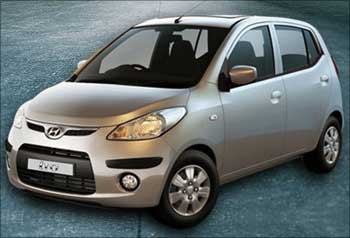
The balloons, streamers, stars and flowers are all over. Workers ready cars for delivery -- there are number plates to screw in, wheels to polish and accessories to fit.
Visitors glide in and out of cars. Located off the busy road that connects Faridabad with Delhi, the Hyundai showroom hopes to sell at least 600 cars in October.
The period is auspicious for Hindus, with Diwali smack in the middle of the month. The Central government has handed out another lot of pay arrears that resulted from the award of the Sixth Pay Commission. Companies have given bonuses to employees. And people are keen to put their money to good use.
In his office above the showroom, Hyundai Motor India managing director & CEO Heung Soo Lheem looks satisfied with the state of affairs. "We are running full three shifts at our two plants (in Tamil Nadu). We hope the momentum will continue after Diwali as well." Lheem has worked 37 years in Hyundai, last close to four in India.
Car makers reckon sales will grow at least ten per cent in 2009. For Hyundai, it is important that sales grow at a fast clip.
Its production (600,000 cars per annum or 50,000 per month) is at present split equally between local sales and exports.
Several countries in the West had announced 'scrappage' incentives for buyers of fuel-efficient cars. This gave a huge momentum to exporters like Hyundai. But now the incentives have begun to run out.
Lheem admits getting new export orders has become tough. Hyundai Motor India senior vice-president (marketing & sales) Arvind Saxena says exports in 2009 may fall about 10,000 short of local sales, and the gap may double in 2010. It is therefore crucial for Hyundai to do well in India.
Hyundai sits on 23 per cent of the Indian car market. But the market place is turning crowded by the day.
Leader Maruti Suzuki (market share: 52 per cent) has strengthened its small car portfolio with launches like the A-Star, Ritz and new Zen Estillo. Fiat has begun its new innings with the Linea and Punto.
Ford has announced a new small car for India called the Figo. Nissan has set its sights on a 5 per cent market share. General Motors wants a 10 per cent slice of the pie.
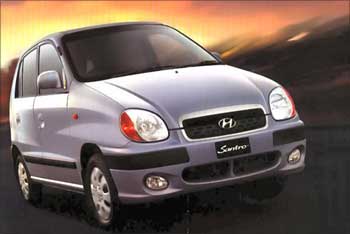
Portfolio makeover
Small cars account for over 75 per cent of the Indian market. The economic slowdown of the last one year has reinforced consumers' preference for fuel-efficient and inexpensive small cars. According to Saxena, almost a quarter of Hyundai's repeat customers now own two small cars. In the past, the second purchase was invariably a mid-sized sedan.
And Hyundai knows this is where the future lies. The Korean chaebol has made India its hub for small cars in the world. Models like the Santro, i10 and i20 are not made anywhere else in the world. This ensures, Lheem claims, that the cars sold in India are of global standards. But it cuts the other way too. Often cars for the overseas market need to be fitted with expensive components and material; this drives up the price in India.
To consolidate its position, Hyundai launched the i10 in October 2007 and the i20 in December 2008. In September, it gave a facelift to its old warhorse, the Santro. The company has sold 11,000 to 12,000 i10s, about 7,000 Santros and between 4,200 and 5,000 i20s every month this year. The surprise here was the i20. "We expected to sell not more than 700 every month," says Lheem. The car's export volumes have been cut, says Saxena, to feed the domestic market.
The Getz will be taken off the road soon. In the works is a new 800-cc, 3-cylinder car somewhere in a Hyundai laboratory in South Korea. The brief to the engineers, says Lheem, is to keep the price below $6,000 (approximately Rs 300,000). "It will be smaller than the Santro in price as well as size," adds Saxena. The car, which is yet to get a name, could take another two or three years before it launches.
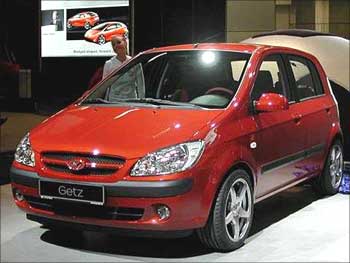
The focus on small cars has had an unexpected fallout. Sector experts say that Hyundai faces a problem similar to Maruti Suzuki -- consumers feel that it is good only with small cars.
"Globally, Hyundai is strong in middle- and large-sized cars. But that imagery is somehow missing in India," says Synovate Motoresearch Associate Director Sumit Arora.
Lheem says his mix of small and big cars mirrors that of the industry -- 75:25 -- but admits that people perhaps are more familiar with the brand Santro than Hyundai.
Privately, car makers admit that real money is in middle- and large-sized cars. The profit margins in small cars are just a fraction. To be fair, Hyundai does have more than one brand in this segment: the Verna, Accent, Sonata and Tuscon. It has withdrawn the Elantra and wants to plug that gap between the Accent and Sonata with a new brand. The SUV portfolio will see the Santa Fe in addition to the Tuscon.
Still, Lheem says he has to fight an unfair battle against the likes of Honda and Toyota in this segment as they import parts free of duty from Thailand. (India and Thailand have a free-trade agreement.)
The answer, he says, is to buy more and more components from within India. Lheem admits that not all his cars sell at a profit, in India as well as abroad. He doesn't name them but says some exports of "developing country" models are being done at a loss.
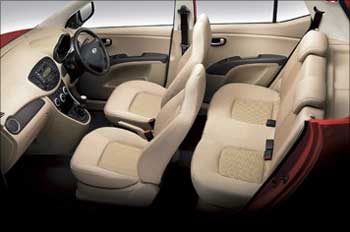
Some experts believe there is enough headroom in the small car market for all to grow. "More car buyers are getting into the market," says Ernst & Young Partner Kapil Arora.
"Customers were always price-sensitive; they have now become value conscious they want small cars with more features." This might be true. Saxena says Hyundai gets almost 45 per cent of its volumes from first-time buyers, up from 33 per cent a few years ago.
To cater to price-sensitive customers, several car makers have extracted the last ounce of profit from their vendors. Component manufacturers have complained for long that business is tough.
Car makers have used the threat of sourcing from China to beat down prices. More and more of them also want full control over sales in the lucrative retail market. Lheem says he has offered all vendors who get a majority of their business from Hyundai financial compensation in case they begin to lose money. "Thankfully, nobody has come to me so far," says he.
Diesel for growth
India has for long subsidised diesel more heavily than petrol. As a result, a growing number of consumers want to buy cars that run on diesel engines. This was about 20 per cent of the market three years ago.
Now, it stands at 27 per cent. The projections are that the figure will hit 35 per cent in the next three years.
Maruti Suzuki got a strong foothold in this market after it set up a plant at Manesar near Delhi to make 100,000 diesel engines per annum. Hyundai has a limited play in the diesel market.
Its only presence is the diesel i20 fitted with an imported diesel engine. But the company knows that if it wants to increase its market share, it needs to do much more. At the moment, the company is studying the feasibility of a factory to make 120,000 to 150,000 small diesel engines every year.
The investment, according to Saxena, could be as much as Rs 1,200 crore. A decision is expected by the end of the year. "The industry has to move towards diesel," says Arora of Synovate. Hyundai needs to move fast with its plans.
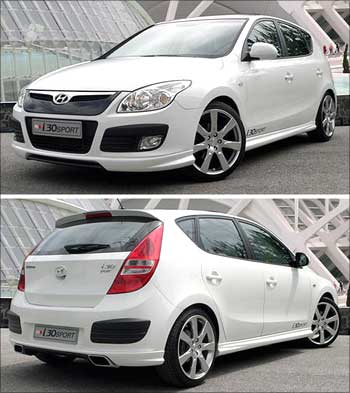
Dealer upgrade
Recent research by Synovate shows that when markets turn bad, as they did in the country till a few months back, buyers prefer to go for brands that have a wider presence. It reassures them that the company will not go out of business.
And for that a large dealer network for sales as well as repairs and service is essential. At present, Hyundai has 272 dealers across 190 cities and towns. The company plans to raise the network to 300 across 230 cities and towns by the end of the year, though Lheem feels 295 would be a more reasonable number.
Saxena feels this more or less covers the entire country. "The top ten cities sell 60 per cent of the cars in the country, and the top 20 sell 75 per cent. Beyond what we plan is not profitable," says he.
Dealers are clearly an important cog in the Hyundai game plan. The key therefore is to boost the profitability of the dealers. What Lheem has done is that he has channeled all sales of spare parts through the dealers.
Even the 700-odd authorised service stations have no option but to buy components from dealers. The logic is simple: While the profit margins on car sales are low (the industry average is below eight per cent), those on spares can be as high as 60 per cent.
Hyundai has been around for 10 years in the country now and there are 1.5 million Santros on the road. The service volume is not negligible.
Meanwhile, the company has also worked with dealers to improve their showrooms and service infrastructure.
Hyundai every year rates its dealers collectively on a scale of 1,000. Last year, the score was 800. Lheem had set a target of 950 by the end of 2009.
By mid-October, it has hit 905. "We have seen at least 15 per cent improvement in most of our dealers," says Lheem. He also plans to convert 100 of them into elite dealers.

Finance matters
A large dealer network may be fine, but for footfalls to convert into purchases, credit is the key. In the last one year, private banks as well as non-bank finance companies, which had fuelled the last boom in car sales, have turned conservative. Earlier, they had financed up to 90 per cent of the cars sold only around 10 per cent customers bought cash down.
The number shot up to 40 per cent in December 2008, thanks to the financial meltdown, it has since dropped to 33 per cent.
Saxena is of the view that unless it falls to 15 per cent to 20 per cent, car sales are unlikely to boom like in 2006 and 2007. Hyundai has thus quietly tied up with about a dozen state-owned banks which have been "gently persuaded" by the government to lend freely. (This is a part of its stimulus to revive the fortunes of the economy.)
These banks lend freely to Hyundai's customers. In return, Hyundai dealers have given business to these banks. They source, for instance, all their working capital from them.
So far, the trick seems to have worked. State-owned banks accounted for about 15 per cent of Hyundai's sales a year ago; today, they contribute as much as 29 per cent.
It is every chief executive's job, Lheem waxes philosophical, to aim for market leadership. Though he refuses to disclose his targets, these initiatives he hopes will help bridge the gap with Maruti Suzuki.